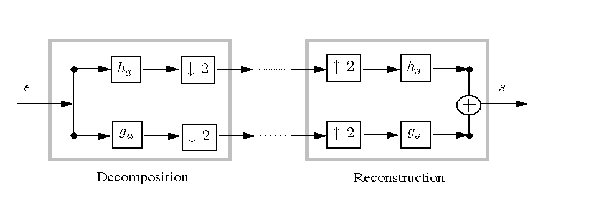

| Wavelet Toolbox |   |
Lifting Background
The DWT is defined by four filters as described in The Fast Wavelet Transform (FWT) Algorithm. Two main properties of interest are
To illustrate the perfect reconstruction property, the following filter bank contains two decomposition filters, ha, ga and two reconstruction filters hs, gs..

The perfect reconstruction property can be expressed by the equality s = e (up to an eventual shift or delay) where the two signals s and e are defined in the following figure:

This leads to the following two conditions referred to as perfect reconstruction(PR):
where Hs(z), Gs(z) are the z-transforms of the filters hs, gs respectively and Ha(-z-1) and Ga(-z-1) are the z-transforms of ha, ga respectively.
The first condition is usually (incorrectly) called the perfect reconstruction condition and the second is the anti-aliasing condition.
Below we refer to the four filters (or equivalently four z-transforms) verifying the (PR) conditions as biorthogonal quadruplets.
The principle of lifting is to generate from a given biorthogonal quadruplet a new one by applying a finite sequence of primal or dual elementary lifting steps (ELS).
A primal ELS generates from the biorthogonal quadruplet (Ha,Ga,Hs,Gs), a new one (HaN,Ga,Hs,GsN) by
where S is any Laurent polynomial.
Let us recall that C is a Laurent polynomial if
involving positive and negative integer powers of z. The degree of C is defined as (pmax-pmin).
Similarly, a dual ELS generates from the same initial biorthogonal quadruplet, a new one (Ha,GaN,HsH,Gs) by
where T is any Laurent polynomial.
These new quadruplets verify the perfect reconstruction conditions (PR). Note that even if the initial biorthogonal quadruplet is associated with "true" wavelets, the new ones are not automatically associated with "true" wavelets but remain useful for discrete wavelet transform of sequences instead of functions.
The previous results are sufficient to generate lifted quadruplets. Nevertheless, by introducing the polyphase matrix, interesting theoretical and algorithmic results can be derived. The synthesis polyphase matrix P associated with the biorthogonal quadruplet (Ha,Ga,Hs,Gs) is the 2-by-2 matrix defined (using the MATLAB conventions) by
Then after a primal lifting the new polyphase matrix PN is obtained simply from P the initial one by:
P itself can be decomposed, up to a normalization, as a product of matrices of the form [1 S(z) ; 0 1] or [1 0 ; T(z) 1] as soon as P is associated with a biorthogonal quadruplet. This form leads to the efficient polyphase algorithm (see [StrN96] in References) because the inverses of such elementary matrices are explicit.
Another useful consequence is that any biorthogonal quadruplet can be obtained by a sequence of ELS, up to a normalization, starting from a particular seed called the "lazy" wavelet (which is not a "true" wavelet and which simply separates odd and even samples of the filter bank input signal).
So, in the Wavelet Toolbox, the key structure to perform what we commonly call the lifting wavelet transform (LWT) is a lifting scheme, which is simply a sequence of ELS and normalization steps.
 | Lifting Method for Constructing Wavelets | Lifting Functions |  |
© 1994-2005 The MathWorks, Inc.